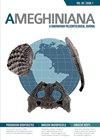A New Basal Notoungulate from the Itaboraí Basin (Paleogene) of Brazil
IF 1.5
4区 地球科学
Q3 PALEONTOLOGY
引用次数: 1
Abstract
Abstract. A new basal notoungulate, Nanolophodon tutuca gen. et sp. nov., is described. This is represented by maxillary and dental fragments and by isolated teeth. The holotype and referred material were found at the “1968 Fissure” of the Itaboraí Basin, Rio de Janeiro State, Brazil. This basin has been regarded as early Eocene in recent contributions. The generalized appearance and brachydonty of the studied specimens, together with the presence of certain typical traits (poorly developed entolophid, well-developed metacone column, etc.) indicate that N. tutuca can be considered among the group of genera traditionally known as henricosborniids, easily distinguishable from Typotheria by the absence of crista 1 and from Toxodontia by the absence of crista intermedia. It is also different from all other henricosborniids by a combination of characters, such as the presence of a long crochet, the development of two small cristae in the ectoloph, and the large paraconid, among others. In the context of a phylogenetic analysis performed, we do not find conclusive evidence about the synonymy between Itaboraitherium atavum and Othnielmarshia pristina. In turn, we question the reference of these forms as henricosborniids, based on the complex occlusal dental pattern observed in both cases. Finally, based on the observations made in the present study, we discuss the identification of the paraconid in notoungulates, which may be associated with some cusps located mesially to the metaconid and identified as pseudoparaconids in past studies.巴西Itaboraí盆地(古近系)一种新的基底无蹄类
摘要报道了一种新的基础无节肢动物Nanolophodon tutuca gen. et sp. nov.。这是代表上颌和牙齿碎片和孤立的牙齿。在巴西巴西里约热内卢州Itaboraí盆地的“1968裂缝”中发现了完整的模型和参考材料。在最近的贡献中,该盆地被认为是早始新世。所研究标本的总体外观和短齿,以及某些典型特征(发育不良的鼻虫,发育良好的元锥柱等)的存在表明,N. tutuca可以被认为是传统上被称为henricosborniids的属群之一,由于缺乏嵴1,很容易与Typotheria区分开来,并且由于缺乏中嵴而与Toxodontia区分开来。它也不同于所有其他henricosbornid的特征组合,例如存在一个长钩针,在生态鞘中发育两个小嵴,以及大的副嵴,等等。在系统发育分析的背景下,我们没有发现关于Itaboraitherium atavum和Othnielmarshia pristina之间同义关系的确凿证据。反过来,我们质疑参考这些形式作为henricosborniids,基于复杂的咬合牙模式观察到在这两种情况下。最后,根据本研究的观察结果,我们讨论了在非节肢动物中对副纲的识别,这可能与一些位于副纲附近的尖头有关,这些尖头在过去的研究中被鉴定为伪副纲。
本文章由计算机程序翻译,如有差异,请以英文原文为准。
求助全文
约1分钟内获得全文
求助全文
来源期刊

Ameghiniana
地学-古生物学
CiteScore
2.50
自引率
10.00%
发文量
21
期刊介绍:
Ameghiniana is a bimonthly journal that publishes original contributions on all disciplines related to paleontology, with a special focus on the paleontology of Gondwana and the biotic history of the southern hemisphere. Published yearly since 1957, it has undoubtedly become the main palaeontological publication from Latin America. Ameghiniana has recently broadened its editorial board, reorganized its production process, and increased to a bimonthly frequency, which resulted in a significant decrease in the turn around time.
 求助内容:
求助内容: 应助结果提醒方式:
应助结果提醒方式:


